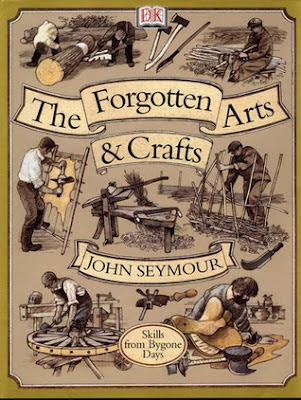Reviewing the Classics: John Seymour's Forgotten Arts
John Seymour was an advocate for the good life: for simple gaeties, gardening and farming, husbandry and general craftsmanship. Having grown up on a small rural plot, he enjoyed gleaning everything he needed from his own freehold: he wore the wool from his own sheep, ate the produce from his farm and garden, and learned a multitude of skills that helped him to become completely self-reliant. He published a variety of books about self-sufficiency, and was a firm believer in the idea that we are more than able to take care of ourselves. The more he saw people get taken in by workhouses and factories, the less he liked modernization and mechanized farming. People who would have otherwise been excellent craftsmen squandered their talents by trading a few hard years in a traditional apprenticeship for good money in a factory pushing buttons, and after fifty years of watching his home being taken over by an industrial way of life, John Seymour decided that the ways of life and crafts of yesteryear must be documented if they were to be preserved.
In Seymour's book on self-sufficiency, he details all of the duties required to keep a small freehold running from how to plough a grassland to how to grins your own wheat. There were, however, many other crafts needed to keep everything on an independent land running smoothly: a blacksmith to fashion and fix tools, a cartwright to mend a dray, a leatherworker to tan and cure hides, a sawyer to fell trees and cut timber, a thatcher to fix roofs and ricks, a dry stone waller to mend the borders between lands, a cooper for barrels-- all in all, a grand collection of highly skilled craftsmen who depended upon one another's abilities for sustainability. Seymour observed that though many people were growing more fond of the good life, of hard land labour with enormous rewards, the craftsmen upon whom many aspects of this life depended were rapidly dwindling. Apprentices were scarce, many of these ancient crafts were now being handled by machine, and skills that were once widely spread and well-paying were now mere curiosities with a few men and women left in each profession to mark their passing. Seymour visited with all the ancient masters- the farrier, the wainwright, the shipbuilder, the bodger, the charcoal burner, the wood turner- and wrote down all their ancient techniques along with his own anecdotes to make The Forgotten Arts.All crafts and skills that are in no danger of being forgotten, like crocheting and sewing, are not documented, but everything else from soap making to chandlery can be found between the two covers. This book is an invaluable resource, whether you would like to try these skills or use the book as a reference. The version I have of this book is the original hardcover copy, but I'm told there is a new one that includes the household crafts as well.
Highly recommended!
In Seymour's book on self-sufficiency, he details all of the duties required to keep a small freehold running from how to plough a grassland to how to grins your own wheat. There were, however, many other crafts needed to keep everything on an independent land running smoothly: a blacksmith to fashion and fix tools, a cartwright to mend a dray, a leatherworker to tan and cure hides, a sawyer to fell trees and cut timber, a thatcher to fix roofs and ricks, a dry stone waller to mend the borders between lands, a cooper for barrels-- all in all, a grand collection of highly skilled craftsmen who depended upon one another's abilities for sustainability. Seymour observed that though many people were growing more fond of the good life, of hard land labour with enormous rewards, the craftsmen upon whom many aspects of this life depended were rapidly dwindling. Apprentices were scarce, many of these ancient crafts were now being handled by machine, and skills that were once widely spread and well-paying were now mere curiosities with a few men and women left in each profession to mark their passing. Seymour visited with all the ancient masters- the farrier, the wainwright, the shipbuilder, the bodger, the charcoal burner, the wood turner- and wrote down all their ancient techniques along with his own anecdotes to make The Forgotten Arts.All crafts and skills that are in no danger of being forgotten, like crocheting and sewing, are not documented, but everything else from soap making to chandlery can be found between the two covers. This book is an invaluable resource, whether you would like to try these skills or use the book as a reference. The version I have of this book is the original hardcover copy, but I'm told there is a new one that includes the household crafts as well.
Highly recommended!


Excellent review! I appreciate the point he is making. Thanks!
ReplyDelete